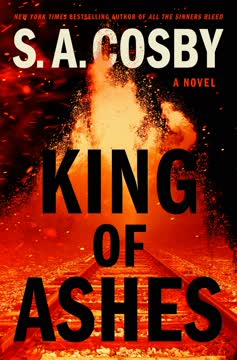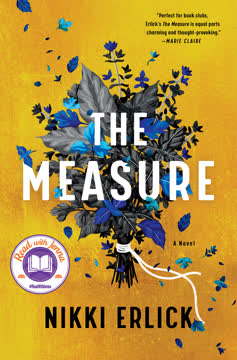Plot Summary
Crimson Fields of Sleep
In a remote California desert, the Poppy Fields facility offers a radical treatment: patients suffering from devastating loss are put into a medically induced sleep for weeks, hoping to awaken healed. The red pajamas and rows of beds evoke a field of poppies, but these are not flowers—they are people, each carrying heartbreak, each seeking relief from pain that feels insurmountable. Some are eager, some afraid, all are united by the hope that sleep might help when nothing else can. The Poppy Fields is both a refuge and a mystery, a place where the only way out of suffering is through, but not necessarily awake.
Three Strangers, One Storm
Ava, an anxious artist from Kansas, Sasha, a grieving occupational therapist from Boston, and Ray, a firefighter haunted by his brother's death, are all stranded at the Kansas City airport by a tornado. Each is en route to the Poppy Fields for reasons they keep close: Ava to find her estranged sister, Sasha to beg for a second chance at sleep after rejection, Ray to confront the place he blames for his brother's demise. Their chance meeting in the chaos forges a bond, setting them on a shared journey west.
Tornadoes and Tangled Fates
As the tornado grounds flights and upends plans, Ava, Sasha, and Ray are forced to improvise. With flights canceled and rental cars scarce, they pool resources and decide to drive cross-country together. Each carries secrets and wounds: Ava's obsessive need for control, Sasha's guilt over her fiancé's death, Ray's unresolved anger and shame. Their journey is both literal and emotional, as the open road becomes a crucible for confession, connection, and transformation.
The Road Trip Pact
The trio, joined by Ava's dog PJ, set out in a battered yellow sedan, "the Canary." Along the way, they pick up Sky, a free-spirited recent graduate hitchhiking west. The car becomes a microcosm of grief, hope, and human messiness. As they traverse the heartland, they share stories, challenge each other's beliefs, and confront the reasons that brought them to the edge of the desert. The journey is punctuated by mishaps—storms, flat tires, and detours—but also by moments of laughter, vulnerability, and unexpected joy.
Secrets in the Desert
As the miles pass, secrets unravel. Sasha reveals the depth of her guilt over her fiancé Dean's death, believing her doubts about their wedding somehow caused his fatal accident. Ray confesses his role in pushing his brother Johnny toward the Poppy Fields, then being unable to forgive himself after Johnny's sudden death. Ava, hiding her true connection to the Fields, finally admits her sister isn't a patient but the facility's founder. These revelations test and ultimately strengthen their fragile trust.
The Science of Grief
The Poppy Fields, founded by the brilliant but emotionally distant Ellis Jones (Ava's sister), is both a scientific marvel and a lightning rod for controversy. The treatment promises to ease the sharpest pain of loss, but at a cost: about a quarter of patients awaken with "emotional moderation," a numbing side effect that erases not just pain but also the depth of love for the lost. Ellis, herself a product of loss, is driven by ambition and haunted by the imperfection of her creation. The Fields becomes a battleground for debates about the ethics of erasing grief.
The Side Effect Revealed
Through interviews, news articles, and personal stories, the narrative explores the consequences of the Fields' treatment. For some, the side effect is a blessing, freeing them from unbearable sorrow. For others, it is a second, more insidious loss—the erasure of love's memory. Families are divided, critics protest, and Ellis herself is not immune: after her grandmother's death, she undergoes the sleep and awakens unable to feel the love she once had for her family. The side effect becomes the story's moral and emotional fulcrum.
Love, Loss, and Guilt
The travelers' stories intertwine with those of the Fields' patients: a mother who lost her son, a widower, a woman mourning her best friend. Each narrative probes the complexity of grief—how it is shaped by guilt, anger, fear, and the longing for relief. Ray's guilt over Johnny's death, Sasha's self-blame for Dean's, and Ava's resentment toward Ellis all echo the central question: can pain be healed without losing what made love meaningful?
The Wall of Memories
At the heart of the Fields is a wall covered in photographs—not of the sleepers, but of those they grieve. This wall is a silent testament to love and loss, a reminder that every patient's story is rooted in connection. Ray, seeking answers about Johnny, is moved by the realization that grief is both universal and deeply personal. The wall becomes a symbol of what endures even when memory and feeling fade.
Sisters Divided, Sisters Reunited
Ava and Ellis finally face each other at the Fields. Ava confronts Ellis for abandoning her after their grandmother's death, only to learn that Ellis was herself a patient, and that the side effect has left her unable to feel the love she once had for her family. Their conversation is raw, painful, and ultimately redemptive. Both sisters acknowledge their flaws and the ways they've hurt each other, opening the door to forgiveness and the possibility of rebuilding their bond.
Choosing to Sleep, Choosing to Wake
Ray, after seeing the Fields and hearing Ellis's account of Johnny's final days, decides to undergo the sleep himself—not to erase his pain, but to understand his brother's choice and seek his own peace. Sasha, after a transformative hike in Sedona and a conversation with a wise widow, chooses not to sleep, realizing that her healing will come with time and connection, not oblivion. The story affirms that while the Fields offers one path, it is not the only way through grief.
The Weight of Goodbye
The travelers part ways, changed by their journey. Sky continues her adventures, sending sunset photos to her friends. Sasha returns to her life and work, carrying Dean's memory with her. Ava and Ellis begin the slow work of reconciliation, patching the fabric of their family. Ray, after his sleep, finds a measure of acceptance and a renewed sense of purpose. Each character learns that grief is not something to be cured, but something to be carried, transformed, and shared.
The Protest and the Push
As the Fields faces growing criticism and a viral protest incident, Ellis is physically attacked by a grieving husband whose wife suffered the side effect. The confrontation shakes Ellis, forcing her to confront the limits of her control and the unintended consequences of her ambition. The Fields' future hangs in the balance as staff and donors question its mission and leadership.
Sedona Detours and Self-Discovery
A spontaneous stop in Sedona, prompted by Sky, gives the travelers a chance to reflect and reset. Sasha's birthday hike becomes a moment of clarity—she realizes she is not ready to let go of her love for Dean, and that healing will come in its own time. The desert landscape, with its ancient rocks and open sky, becomes a metaphor for resilience and the slow, patient work of survival.
Letting Go, Holding On
The story's final chapters explore the tension between letting go of pain and holding on to love. Through conversations, letters, and memories, the characters grapple with the idea that to heal is not to forget, but to integrate loss into the fabric of life. The Poppy Fields, like the poppy flower itself, becomes a symbol of growth from ruin—a place where new life can emerge from devastation, but not without cost.
The End of the Road
The road trip concludes at the Fields, but the characters' journeys are ongoing. The Fields itself undergoes a transformation, with Ellis stepping down and her colleague Yasmin taking the helm. The story closes with glimpses of the characters' futures: Sky surfing on the coast, Sasha returning to her patients, Ava and Ellis rebuilding their relationship, Ray honoring his brother's memory. The message is clear: grief changes us, but it does not define us.
New Beginnings, Old Wounds
In the aftermath of their journey, the characters find new beginnings—friendships, reconciliations, and a renewed sense of purpose. Yet old wounds linger, and the work of healing continues. The Poppy Fields remains both a sanctuary and a question mark, a place where the boundaries between science and love, forgetting and remembering, are forever blurred.
Characters
Ava Jones
Ava is a gentle, anxious illustrator from Kansas, shaped by early loss and raised by her grandmother alongside her older sister, Ellis. Her life is defined by routines, small comforts, and a deep-seated fear of change. The death of her grandmother leaves her unmoored and estranged from Ellis, whose ambition and distance she resents. Ava's journey to the Poppy Fields is both a quest to confront her sister and a search for closure. Through the road trip and her eventual reconciliation with Ellis, Ava learns to assert herself, embrace imperfection, and open herself to new relationships, including a tentative romance with Ray. Her arc is one of quiet courage and the healing power of forgiveness.
Ellis (Emmy) Jones
Ellis is the architect of the Poppy Fields, a neurobiologist whose ambition is fueled by early trauma and a desire to leave a mark on the world. She is both visionary and flawed, capable of great empathy for her patients but often blind to the needs of her own family. After her grandmother's death, Ellis undergoes her own treatment and suffers the side effect, losing the ability to feel love for her family. This emotional numbness becomes her greatest regret and the source of her estrangement from Ava. Ellis's journey is one of reckoning—with her creation, her legacy, and her own limitations. By the end, she steps back from leadership, seeking to repair her relationship with Ava and to find meaning beyond achievement.
Sasha Kim
Sasha is an occupational therapist from Boston, reeling from the sudden death of her fiancé, Dean, just before their wedding. Her grief is complicated by guilt—she had doubts about the marriage, and his death feels like a cosmic punishment. Initially desperate to sleep at the Fields and erase her pain, Sasha's journey with Ava and Ray, and a transformative hike in Sedona, lead her to choose a different path. She realizes that healing is slow, nonlinear, and deeply personal. Sasha's arc is about accepting imperfection, letting go of self-blame, and finding hope in connection and memory.
Ray
Ray is a Kansas City firefighter whose younger brother, Johnny, also a first responder, died shortly after sleeping at the Poppy Fields. Ray is tormented by guilt—he discouraged Johnny from seeking help, then lost the chance to reconcile. His journey to the Fields is driven by a need for answers and a hope for redemption. Through the road trip and his eventual decision to undergo the sleep himself, Ray confronts the limits of control, the complexity of grief, and the possibility of forgiveness. His story is a meditation on masculinity, vulnerability, and the enduring bonds of brotherhood.
Sky
Sky is a recent high school graduate hitchhiking west, embodying youthful curiosity and a hunger for experience. Her presence in the story is both comic and profound—she challenges the older travelers to embrace spontaneity, confront their fears, and see the world anew. Sky's own journey is shaped by a brush with mortality at a party, prompting her to seize life's opportunities. She is a symbol of hope, resilience, and the possibility of new beginnings.
Johnny
Johnny is Ray's younger brother, a paramedic whose cumulative grief leads him to the Poppy Fields. His death, shortly after waking, is the story's central mystery and source of Ray's anguish. Johnny's memory haunts the narrative, his presence felt in dreams, stories, and the wall of photographs. He represents the cost of unacknowledged pain and the tragedy of missed connections.
Dean
Dean is Sasha's late fiancé, a musician and teacher whose sudden death before their wedding leaves Sasha adrift. His memory is preserved in music, dreams, and the ache of what might have been. Dean's story is a meditation on love, regret, and the impossibility of closure.
Yasmin Saeed
Yasmin is Ellis's colleague and eventual successor at the Fields. She is calm, pragmatic, and deeply committed to the mission of healing. Yasmin provides balance to Ellis's ambition, advocating for caution, transparency, and the well-being of patients. Her leadership marks a new chapter for the Fields.
Donna
Donna is a local bar owner who nearly became a patient at the Fields after her husband's death but turned back at the last moment. She offers wisdom and perspective to Sasha, reminding her that healing is a lifelong process and that love's endurance is measured not by absence of pain but by the willingness to keep living.
Jamie Roberts
Jamie is the husband of a woman who suffered the side effect at the Fields, losing her emotional connection to their deceased son. His public protest and confrontation with Ellis force the story to grapple with the ethical and emotional costs of the treatment. Jamie embodies the collateral damage of scientific ambition and the irreducible complexity of grief.
Plot Devices
Interwoven Narratives and Perspectives
The novel employs a mosaic structure, weaving together the journeys of Ava, Sasha, Ray, Sky, and Ellis, as well as interviews, news articles, letters, and transcripts from the Poppy Fields. This polyphonic approach allows for a rich exploration of grief from diverse angles—personal, scientific, societal. The shifting perspectives create empathy, suspense, and a sense of universality, while also highlighting the uniqueness of each character's pain.
The Road Trip as Transformation
The cross-country drive is both a plot engine and a metaphor for the characters' internal journeys. The obstacles—storms, flat tires, detours—force the travelers to confront their fears, reveal their secrets, and forge connections. The road becomes a liminal space where change is possible, and the destination (the Fields) is less important than the growth that occurs along the way.
The Side Effect as Moral Dilemma
The risk of "emotional moderation" is introduced early and recurs throughout, shaping characters' choices and the reader's understanding of the Fields. The side effect is both a literal plot device and a symbol of the dangers of seeking easy solutions to complex pain. It raises questions about the value of suffering, the meaning of love, and the limits of science.
The Wall of Photographs
The wall of photos at the Fields serves as a visual and narrative focal point, representing the enduring presence of the lost and the interconnectedness of grief. It is a site of revelation, reflection, and, ultimately, acceptance—a reminder that love persists even when memory and feeling fade.
Letters, Interviews, and Media
The inclusion of letters, interview transcripts, news articles, and social media posts expands the novel's scope, situating the personal stories within a broader cultural and ethical debate. These devices provide exposition, foreshadowing, and commentary, while also inviting the reader to question the boundaries between public and private grief.
Analysis
The Poppy Fields is a profound meditation on grief, love, and the human longing for relief from suffering. Through its inventive structure and deeply drawn characters, the novel interrogates the costs and consequences of trying to "cure" pain—whether through science, sleep, or avoidance. It refuses easy answers, acknowledging that healing is messy, nonlinear, and often incomplete. The story's central device—the sleep that can erase both agony and affection—forces readers to consider what makes loss bearable: is it the absence of pain, or the persistence of love? By following its characters through storms, deserts, and the labyrinth of memory, the novel ultimately affirms that grief is not a problem to be solved but a testament to the depth of our connections. The Poppy Fields itself becomes a symbol of both hope and hubris, a place where new life can grow from ruin, but only if we are willing to carry both the beauty and the burden of what we have lost.
Last updated:
FAQ
0. Synopsis & Basic Details
What is The Poppy Fields about?
- A Sanctuary for Sorrow: The Poppy Fields explores a mysterious facility in the California desert offering a radical, medically induced sleep treatment designed to heal profound grief and loss. Patients enter a prolonged dormancy, hoping to emerge free from their pain.
- Journeys of Healing: The narrative follows three strangers—Ava, Sasha, and Ray—who, by a twist of fate, embark on a cross-country road trip to reach the enigmatic Poppy Fields, each driven by their own unique and deeply personal reasons for seeking or confronting the treatment.
- The Cost of Comfort: Beyond the central premise, the novel delves into the complexities of human emotion, questioning whether true healing can occur by bypassing pain, and exploring the unforeseen consequences and ethical dilemmas of a treatment that promises relief but risks altering the very nature of love and memory.
Why should I read The Poppy Fields?
- Deep Emotional Resonance: Readers seeking a profound exploration of grief, love, and human connection will find themselves deeply moved by the characters' struggles and triumphs. The novel offers a nuanced perspective on coping with loss, making it a powerful read for anyone navigating personal sorrow.
- Intriguing Ethical Dilemmas: The story presents a fascinating speculative premise—a "cure" for grief—that sparks compelling ethical questions about memory, identity, and the value of suffering. It's a thought-provoking read that encourages readers to consider what it truly means to heal.
- Rich Character Journeys: Beyond the central plot, The Poppy Fields excels in its character development, offering interwoven narratives of individuals grappling with complex emotions, unspoken motivations, and the messy realities of family and relationships. Their personal growth and unexpected connections provide a deeply satisfying reading experience.
What is the background of The Poppy Fields?
- A World Grappling with Loss: The story is set in a contemporary world where grief is recognized as a pervasive, often debilitating, human experience, leading to the emergence of radical solutions like the Poppy Fields. The facility is funded by research grants and donations, highlighting a societal desire to alleviate suffering on a grand scale.
- Scientific Innovation Meets Human Emotion: The Poppy Fields operates as a cutting-edge neurobiology research center, applying scientific principles to emotional recovery. This background grounds the speculative element in a plausible, if advanced, scientific context, inviting readers to consider the intersection of technology and the human psyche.
- Cultural Debates on Grief: The novel implicitly draws on cultural discussions around mental health, the "timeline" of mourning, and the pressure to "move on." The existence of groups like "Stop the Sleep" and public skepticism reflects real-world debates about unconventional therapies and the societal discomfort with visible, prolonged grief.
What are the most memorable quotes in The Poppy Fields?
- "The only way out of a hardship is through. But nobody ever told them that they had to stay awake." (Prologue): This quote encapsulates the core premise of The Poppy Fields, highlighting the novel's central question about whether bypassing conscious suffering is a valid path to healing. It sets the stage for the ethical and emotional exploration of the sleep treatment.
- "Grief was love in its second shape." (Chapter 60): This profound statement, articulated by Ellis, redefines grief not as an absence of love, but as a transformed, enduring form of it. It's a pivotal thematic revelation, suggesting that pain is inextricably linked to the depth of connection, and that true healing integrates, rather than erases, this complex emotion.
- "You just drive it as fast or as slow as you need, don't give a damn what other folks think . . . Just don't stop driving, okay?" (Chapter 56): Donna's advice to Sasha serves as a powerful metaphor for navigating grief and life's challenges. It emphasizes personal agency, self-compassion, and resilience, offering a counter-narrative to the Fields' promise of a quick fix, and resonating as a universal message of perseverance.
What writing style, narrative choices, and literary techniques does Nikki Erlick use?
- Mosaic Narrative Structure: Erlick employs a fragmented, multi-perspective narrative, weaving together the present-day road trip with flashbacks, internal monologues, and external documents like interview transcripts, news articles, and social media posts. This technique provides a comprehensive, layered understanding of the characters' pasts and the broader societal context of the Poppy Fields, enriching the themes in The Poppy Fields.
- Symbolism and Metaphor: The novel is rich with symbolic imagery, from the "crimson carpet" of sleepers resembling poppy fields to the "Canary" car's journey as a metaphor for life's unpredictable path. The desert landscape itself symbolizes isolation and vastness, while the "Wall of Memories" at the Fields becomes a powerful representation of enduring love and collective grief, deepening the symbolism explained.
- Subtle Foreshadowing and Thematic Echoes: Erlick masterfully uses subtle hints and recurring motifs to foreshadow future events and reinforce central themes. For instance, the initial descriptions of Ava's anxiety and Ray's need for control subtly set up their later character developments, while repeated phrases like "the world moves on" underscore the isolating nature of grief and the characters' longing for connection.
1. Hidden Details & Subtle Connections
What are some minor details that add significant meaning?
- PJ's Name and Symbolism: Ava's dog, PJ, named "Pelorus Jack" after a dolphin who guided ships through treacherous waters, subtly foreshadows his role as a comforting and guiding presence for Ava, and later Sasha, throughout their emotionally challenging journey. His consistent presence offers a grounding force amidst the characters' anxieties and uncertainties, highlighting the meaning of PJ's name.
- The Spatula-Key and Unlocked Doors: The gas station restroom key, tied to a greasy spatula, and the unlocked door, symbolize Ava's anxieties about control and vulnerability. This seemingly trivial detail underscores her deep-seated fear of the unknown and her need for security, contrasting with the unexpected openness she finds with Sasha and Ray.
- Ellis's "Emmy" Nickname: The revelation that Ellis's childhood nickname, "Emmy," came from her initials (M.E. Jones) rather than a more affectionate origin, subtly hints at her early, perhaps unconscious, drive for self-definition and ambition, even as a child. This detail foreshadows her later emotional detachment and her focus on legacy over personal connection, providing insight into Ellis Jones's motivations.
What are some subtle foreshadowing and callbacks?
- Ellis's Birthday Reflections and Mae's Wish: Ellis's solitary 35th birthday, spent reflecting on her parents' early deaths and her grandmother Mae's wish to "go in her sleep," subtly foreshadows Ellis's own decision to undergo the sleep treatment after Mae's death. This callback reveals the deeply personal, almost fated, connection between her family's history of loss and her groundbreaking invention, adding layers to Ellis Jones's motivations.
- The Law of Inertia as a Life Metaphor: Ellis's recurring thought about the "law of inertia" ("An object in motion stays in motion... An object at rest stays at rest...") subtly foreshadows the sisters' diverging paths and the effort required to change their trajectory. This scientific concept becomes a powerful metaphor for their emotional and relational inertia, hinting at the profound "external force" (Ava's visit) needed to bring them back together, a key theme in The Poppy Fields.
- Dr. Fred Robinson's Past: The detail that Dr. Fred Robinson, the first patient to grieve a lost livelihood, was a survivor of the same bridge collapse that killed Ellis's parents, is a profound, subtle callback. This hidden connection reveals Ellis's unconscious drive to heal her own past traumas through her work, and later, her decision to offer him a job, suggesting a deeper, almost karmic, link between her personal history and the Fields' mission.
What are some unexpected character connections?
- Johnny's Connection to Jamie Roberts's Son: The "Wall of Memories" reveals that Johnny and Jamie Roberts's wife both grieved the same little boy, the victim of a stray bullet. This unexpected connection highlights the shared, yet deeply personal, nature of trauma among the Fields' patients and their loved ones, underscoring the universal impact of random tragedy and the interconnectedness of grief, a powerful symbolism explained through shared loss.
- Donna's Near-Patient Status: The revelation that Donna, the bar owner, was an approved applicant for the Poppy Fields but chose not to undergo the sleep, creates an unexpected parallel with Sasha. This connection positions Donna as a wise, experienced guide who chose a different path to healing, offering a counterpoint to the Fields' treatment and deepening the exploration of diverse coping mechanisms for grief.
- Sky's Encounter with Johnny: Sky's story of witnessing a heroic medic save a girl at a party, later revealed to be Ray's brother Johnny, creates a poignant, indirect connection between Sky and Ray's deepest pain. This subtle link underscores Johnny's lasting impact on the world and provides Ray with an unexpected source of comfort and pride in his brother's legacy, even in death, adding depth to Johnny's character analysis.
Who are the most significant supporting characters?
- Donna, the Unconventional Sage: Donna, the desert bar owner, serves as a grounded, pragmatic foil to the characters' emotional turmoil and the Fields' scientific ambition. Her decision to turn back from the sleep and her wisdom about "getting on" rather than "getting over" grief provides a crucial alternative perspective on healing, profoundly influencing Sasha's choice and offering a different kind of guidance than the Fields.
- Sky, the Unjaded Catalyst: Sky, the hitchhiking teenager, acts as a catalyst for spontaneity and self-reflection among the older travelers. Her youthful perspective, unburdened by past regrets or future anxieties, challenges Ava, Sasha, and Ray to embrace the present and find joy in unexpected detours. Her story of witnessing a near-death experience (Johnny's save) subtly reinforces the preciousness of life and the importance of living fully.
- Yasmin Saeed, the Ethical Compass: Dr. Yasmin Saeed, Ellis's lead scientist and eventual successor, is more than just a colleague; she represents the ethical conscience of the Poppy Fields. Her calm demeanor, scientific integrity, and consistent push for caution and transparency provide a vital counterpoint to Ellis's ambition and Flynn's commercialism, ensuring the Fields' mission remains rooted in genuine healing, shaping the themes in The Poppy Fields.
2. Psychological, Emotional, & Relational Analysis
What are some unspoken motivations of the characters?
- Ellis's Quest for Control and Legacy: Ellis's relentless ambition and desire to "do something big" are implicitly driven by the early, uncontrollable loss of her parents and grandmother. Her creation of the Poppy Fields is an attempt to exert control over the chaos of grief and to leave an extraordinary mark on the world, a deep-seated Ellis Jones motivation rooted in her past.
- Ray's Need for Absolution: Ray's initial anger and suspicion towards the Poppy Fields, and his determination to find "incriminating" evidence, are unspoken manifestations of his profound guilt over his last interaction with Johnny. He seeks to externalize blame, hoping that if the Fields is at fault, his own self-reproach for not supporting his brother might be absolved, revealing the complexity of Ray's motivations.
- Sasha's Search for Self-Forgiveness: Sasha's desperate desire to sleep at the Fields is not just about alleviating pain, but an unspoken yearning for self-forgiveness. Her belief that her doubts about Dean's wedding caused his death is a form of self-punishment, and the sleep, with its potential for emotional moderation, offers a subconscious escape from this crushing guilt, exploring Sasha Kim's psychological complexities.
What psychological complexities do the characters exhibit?
- Ava's Anxiety and Latent Courage: Ava's meticulous routines and fear of spontaneity (e.g., her aversion to driving, her germophobia) mask a deep-seated anxiety stemming from early loss and abandonment. However, her journey reveals a latent courage, as she pushes past her comfort zone to confront Ellis and embrace new experiences, showcasing her quiet strength and growth in Ava Jones's character analysis.
- Ray's Stoicism as a Shield: Ray's outwardly stoic demeanor and preference for physical exertion (running, firefighting) are psychological defenses against overwhelming grief and vulnerability. His inability to cry or express emotion openly reflects a learned masculinity, but his internal struggle and eventual decision to sleep reveal a deeper need for emotional processing, exploring Ray's psychological complexities.
- Ellis's Ambition and Emotional Blindness: Ellis embodies the complexity of a brilliant mind capable of profound scientific empathy for strangers, yet emotionally blind to the needs of her own family. Her inability to feel love for Mae after the side effect, despite her intellectual understanding of their bond, highlights the tragic irony of her creation and her own emotional cost, a key aspect of Ellis Jones's character analysis.
What are the major emotional turning points?
- Sasha's Sedona Epiphany: Sasha's solo hike in Sedona, culminating in her phone call to her parents on her birthday, marks a significant emotional turning point. This moment of groundedness and connection to her family, coupled with hearing Dean's song played by Sky, helps her realize that healing is a process of integration, not erasure, leading her to choose against the sleep and embrace her grief, a pivotal moment in Sasha Kim's character arc.
- Ray's Encounter with the Wall of Memories: Ray's discovery of the "Wall of Memories" at the Poppy Fields is a profound emotional turning point. Seeing the thousands of faces of the lost, including the boy Johnny grieved, shifts his focus from anger and blame to a deeper understanding of universal grief and the enduring power of love, paving the way for his decision to undergo the sleep himself, central to Ray's character development.
- Ava and Ellis's Confrontation and Reconciliation: The raw, honest confrontation between Ava and Ellis at the Fields, where Ava expresses her pain and Ellis reveals her own experience with the side effect, is the emotional climax of their relationship. This painful but necessary dialogue allows both sisters to acknowledge their flaws and begin the arduous process of forgiveness and rebuilding their fractured bond, a key relationship dynamic explained.
How do relationship dynamics evolve?
- The Found Family of the Road Trip: The initial cautious alliance between Ava, Sasha, and Ray (and later Sky) evolves into a genuine "found family" dynamic. Through shared vulnerabilities, unexpected humor, and mutual support during mishaps, their relationships deepen, demonstrating the healing power of human connection outside of traditional family structures, a core theme in The Poppy Fields.
- Ava and Ellis's Patchwork Sisterhood: The relationship between Ava and Ellis transforms from a childhood bond of "us against the world" to a strained estrangement, and finally, to a tentative, imperfect reconciliation. Ava's courage to confront Ellis, and Ellis's vulnerability in revealing her side effect, allows them to begin patching their relationship, acknowledging their differences while holding onto the enduring thread of their shared past, illustrating sister relationship dynamics.
- Ray's Shifting Grief and Connection: Ray's relationship with Johnny, initially defined by guilt and a need for control, evolves through his journey. His decision to sleep at the Fields, and his later ability to find joy in shared memories with his firehouse family, signifies a shift from isolated suffering to a more integrated, communal experience of grief, showcasing Ray's character development and his evolving relationship with his brother's memory.
4. Interpretation & Debate
Which parts of the story remain ambiguous or open-ended?
- The True Nature of the Side Effect: While described as "emotional moderation," the exact neurological mechanism and long-term implications of the side effect remain ambiguous. The novel leaves open whether it's a true erasure of love or a profound suppression, allowing readers to debate the ethical implications of altering human emotion and the true cost of the Poppy Fields explained.
- The Fields' Ultimate Efficacy: Despite testimonials, the novel maintains a subtle ambiguity about whether the Poppy Fields offers a genuine "cure" or merely a temporary reprieve. The varying experiences of patients (e.g., Sandy Russo vs. Audrey) and the ongoing research to eliminate the side effect suggest that the treatment is still evolving, leaving its ultimate success open to interpretation and fueling interpretive debates.
- The Future of the Characters' Relationships: While the novel offers hopeful resolutions for Ava and Ellis, and hints at a potential romance between Ava and Ray, the long-term stability and depth of these relationships remain open-ended. The characters' journeys are presented as ongoing, reflecting the messy, non-linear nature of healing and human connection, inviting readers to consider the lasting impact of their experiences.
What are some debatable, controversial scenes or moments in The Poppy Fields?
- Ellis's Decision to Sleep and its Aftermath: Ellis's choice to undergo the sleep treatment after Mae's death, and her subsequent experience with the side effect, is highly debatable. Her rationale—to test the treatment and be a better leader—clashes with Ava's perception of abandonment, raising questions about personal sacrifice versus familial obligation and the ethics of self-experimentation, central to Ellis Jones's motivations.
- Jamie Roberts's Attack on Ellis: The physical confrontation between Jamie Roberts and Ellis, fueled by his wife's experience with the side effect, is a controversial moment. It forces readers to confront the raw, often violent, manifestations of grief and the collateral damage of the Fields' treatment, sparking debate about accountability, victimhood, and the limits of empathy in the face of profound loss.
- The "Stop the Sleep" Movement's Allegations: The public backlash against the Poppy Fields, particularly the "Stop the Sleep" movement's claims of brainwashing and abandonment, presents a controversial external debate. While the narrative often frames these critics as misinformed or paranoid, their concerns about the treatment's impact on family bonds and individual autonomy are valid points for discussion, highlighting the controversy surrounding The Poppy Fields.
The Poppy Fields Ending Explained: How It Ends & What It Means
- Healing as Integration, Not Eradication: The ending of The Poppy Fields signifies that true healing from grief is not about erasing pain or forgetting the lost, but about integrating loss into one's life. Sasha chooses not to sleep, embracing the slow, messy process of mourning while holding onto Dean's memory. Ray undergoes the sleep, not to forget Johnny, but to understand his brother's choice and find peace, ultimately adding Johnny's picture to the wall of memories, signifying acceptance. This is a core The Poppy Fields ending explained theme.
- Reconciliation and Imperfect Connections: Ava and Ellis begin the arduous process of repairing their fractured sisterhood, acknowledging their past hurts and differences. Ellis steps down as CEO to focus on research into the side effect and reconnect with Ava, signifying a shift from ambition to human connection. Their relationship, like the patched sweater, is not seamless but functional and loving, emphasizing that family bonds can be rebuilt even after profound rifts, a key aspect of The Poppy Fields analysis.
- The Enduring Power of Love and Choice: The novel concludes with a sense of hope and ongoing journeys for all characters. Sky continues her adventures, embodying freedom and living in the moment. The Poppy Fields itself evolves under Yasmin's leadership, becoming more accessible and ethical. Ultimately, the ending reinforces the idea that while grief is universal, the path through it is deeply personal, and that love, in its many forms, endures and continues to shape us, even in absence, providing a nuanced meaning of The Poppy Fields.
Review Summary
The Poppy Fields is a thought-provoking novel exploring grief and healing through an experimental treatment center. Readers praise Erlick's unique premise, character development, and ability to evoke strong emotions. The story follows multiple characters on a journey to the center, interweaving their experiences with grief. While some found the pacing slow and struggled to connect emotionally, many appreciated the book's philosophical depth and potential for discussion. The audiobook narration received high praise. Overall, reviewers found the novel compelling, albeit emotionally heavy, and recommend it for book clubs.
Similar Books
Download PDF
Download EPUB
.epub digital book format is ideal for reading ebooks on phones, tablets, and e-readers.
















